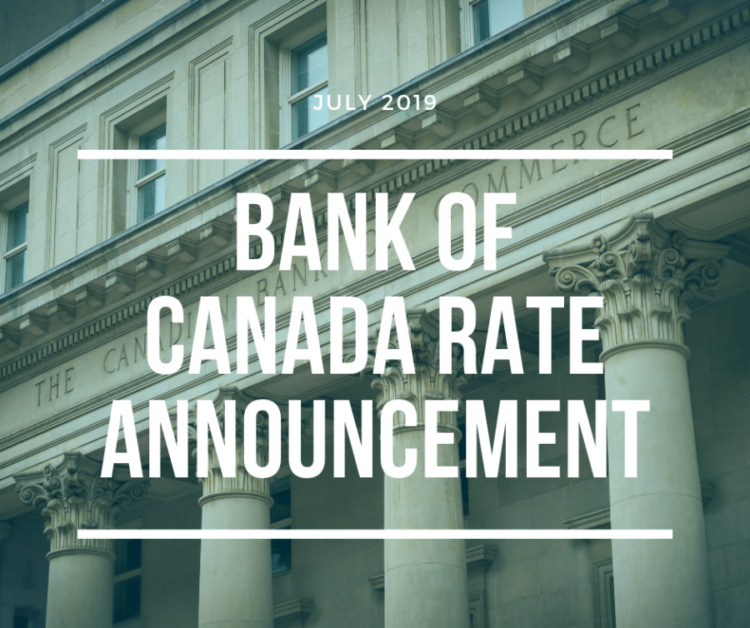OTTAWA — Bank of Canada governor Stephen Poloz is holding firm on his key interest rate and showing no urgency to make a policy change, positions that come with the U.S. Federal Reserve poised to cut its rate.
The Bank of Canada’s decision Wednesday kept the interest rate target at 1.75 per cent for a sixth-straight meeting as the country bounces back from a weak stretch that nearly brought the economy to a halt in late 2018 and early 2019.
The policy announcement warned how widening global trade conflicts are taking an economic toll, and posing a threat to Canada’s stronger-than-expected rebound.
The bank’s governing council appeared to be in no rush to move the rate, even as they acknowledged policy-makers in the U.S. and Europe have signalled they may lower interest rates to respond to the weakening world economy.
“Recent data show the Canadian economy is returning to potential growth,” the Bank of Canada said in a statement.
“However, the outlook is clouded by persistent trade tensions. Taken together, the degree of accommodation being provided by the current policy interest rate remains appropriate.”
U.S. Federal Reserve chairman Jerome Powell signalled Wednesday that a U.S. rate cut was likely later this month due to slowing global growth and trade conflicts. It would be the first reduction in more than a decade.
However, Carolyn Wilkins, the Bank of Canada’s senior deputy governor, explained Wednesday that the countries are at different points in the economic cycle.
“The U.S. is slowing to a more sustainable pace, while Canada is moving back up to its trend growth,” Wilkins said.
“Activity here at home is being supported by a policy rate that’s lower than south of the border.”
She predicted similar growth in both economies by the second half of 2019 — and argued the process is one of “convergence” rather than “divergence.”
Wilkins said the uncertain trade environment is the “biggest wild card” in the outlook.
In its latest quarterly projections, also released Wednesday, the central bank downgraded its 2019 global growth forecast to three per cent from 3.2 per cent due to trade disputes. It underscored, in particular, how the impacts of the U.S.-China trade fight have rippled through the world’s economy.
“Escalating trade conflicts, geopolitical tensions and related uncertainty are contributing to the broad-based slowdown of global economic activity,” the bank said in its latest monetary policy report.
Wilkins said the bank estimates the combined fallout will lower Canada’s gross domestic product by as much as two per cent by the end of 2021.
Closer to home, direct trade actions are also having an impact on Canada.
China’s recent trade actions on meat and canola products from Canada are expected to lower exports by 0.2 per cent, the bank said. The changes, including stricter inspections on Canadian goods by Chinese authorities, have come amid a bilateral diplomatic dispute.
The bank predicted economic growth in Canada this year of 1.3 per cent, up slightly from its April forecast of 1.2 per cent, and an expansion of 1.9 per cent in 2020, down from its previous call of 2.1 per cent.
The Bank of Canada raised its forecast for second-quarter growth to an annual pace of 2.3 per cent, up from its April projection of 1.3 per cent, following the surprisingly swift rebound from the slowdown at the start of the year. It predicted growth an annual pace of 1.5 per cent for the third quarter.
The robust bounce back, the bank said, was due to temporary factors such as a recovery from weather-related weaknesses and a boost in oil production.
Consumption in Canada is being supported by the healthy job market and rising wages, while the housing market at a country-wide level is stabilizing, the bank said. In addition, climate-related incentive payments from the federal government, which are front-loaded, could also provide a temporary boost to household spending.
The Bank of Canada said it will continue to monitor data ahead of future decisions with a particular focus on developments in the energy sector and the effects of global trade tensions.
Follow @AndyBlatchford on Twitter
Andy Blatchford, The Canadian Press

 Buying a Home5 years ago
Buying a Home5 years ago
 Credit6 years ago
Credit6 years ago
 5 Mortgage Secrets6 years ago
5 Mortgage Secrets6 years ago
 Business4 years ago
Business4 years ago
 Buying a Home6 years ago
Buying a Home6 years ago
 5 Mortgage Secrets6 years ago
5 Mortgage Secrets6 years ago
 Business4 years ago
Business4 years ago
 Buying a Home6 years ago
Buying a Home6 years ago






